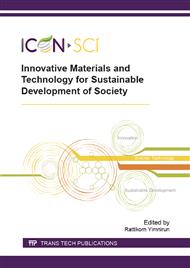p.171
p.175
p.179
p.183
p.187
p.191
p.195
p.199
p.203
Characterization and Gel Properties of Gelatin Extracted from Waste Fish Scales
Abstract:
The objective of this research is to compare the characteristic of gelatin prepared from waste fish scales. White perch, java barb, red tilapia and nile tilapia scales were cleaned and treated with 1.0 M NaOHfor 2 h at room temperature to remove fat and then treated 0.8 M acetic acid to restructure of fish scales. Gelatin from waste fish scales were exacted using heating the cleaned fish scales in the distilled water at 70 °C for 2 h. Gelatins were characterization by UV-vis spectrometer, viscometer, X-ray diffraction (XRD), fourier transform infrared spectrophotometer (FT-IR) and scanning electron microscopy (SEM). The results shown the amount of gelatin and percent transmittance of light of gelatin from white perch was more than that of other waste fish scales. The viscosities of all gelatins decreased with increasing temperature. The gelatin from java bard was more viscosity than that from other fish scales due to more amounts of aspartic and glutamic acid. The XRD intensity of gelatin from white perch scales and java barb scales had higher than that from other fish scales confirming the higher crystallinity of gelatin. The FT-IR resultsindicated the same function groupsof all gelatins. SEM results revealed the porous structure of all gelatins. The all results concluded that gelatin property of nile tilapia scales had less than that of other fish scales which could be used in different industry.
Info:
Periodical:
Pages:
187-190
Citation:
Online since:
October 2015
Keywords:
Price:
Сopyright:
© 2015 Trans Tech Publications Ltd. All Rights Reserved
Share:
Citation:


